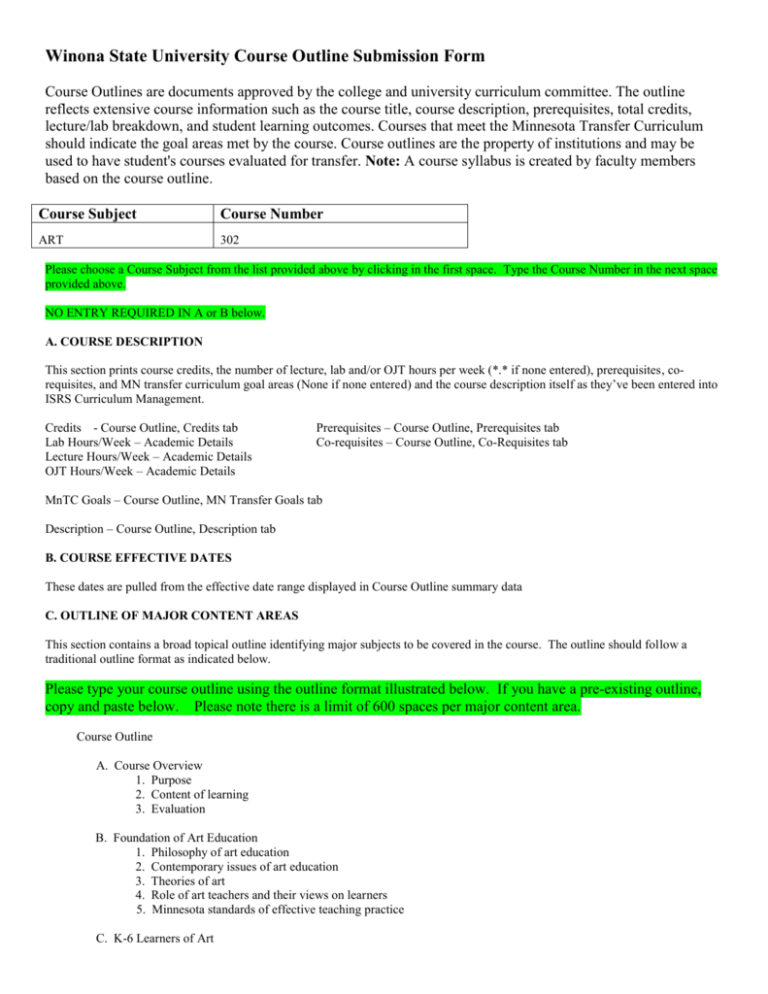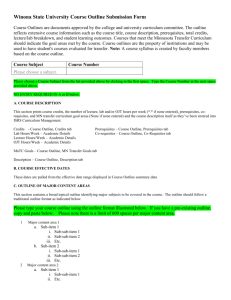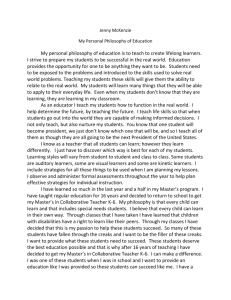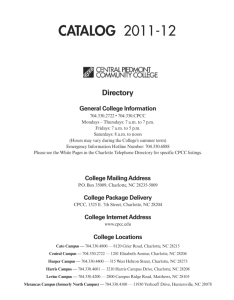ART 302 Outline - Winona State University
advertisement

Winona State University Course Outline Submission Form Course Outlines are documents approved by the college and university curriculum committee. The outline reflects extensive course information such as the course title, course description, prerequisites, total credits, lecture/lab breakdown, and student learning outcomes. Courses that meet the Minnesota Transfer Curriculum should indicate the goal areas met by the course. Course outlines are the property of institutions and may be used to have student's courses evaluated for transfer. Note: A course syllabus is created by faculty members based on the course outline. Course Subject Course Number ART 302 Please choose a Course Subject from the list provided above by clicking in the first space. Type the Course Number in the next space provided above. NO ENTRY REQUIRED IN A or B below. A. COURSE DESCRIPTION This section prints course credits, the number of lecture, lab and/or OJT hours per week (*.* if none entered), prerequisites, corequisites, and MN transfer curriculum goal areas (None if none entered) and the course description itself as they’ve been entered into ISRS Curriculum Management. Credits - Course Outline, Credits tab Lab Hours/Week – Academic Details Lecture Hours/Week – Academic Details OJT Hours/Week – Academic Details Prerequisites – Course Outline, Prerequisites tab Co-requisites – Course Outline, Co-Requisites tab MnTC Goals – Course Outline, MN Transfer Goals tab Description – Course Outline, Description tab B. COURSE EFFECTIVE DATES These dates are pulled from the effective date range displayed in Course Outline summary data C. OUTLINE OF MAJOR CONTENT AREAS This section contains a broad topical outline identifying major subjects to be covered in the course. The outline should follow a traditional outline format as indicated below. Please type your course outline using the outline format illustrated below. If you have a pre-existing outline, copy and paste below. Please note there is a limit of 600 spaces per major content area. Course Outline A. Course Overview 1. Purpose 2. Content of learning 3. Evaluation B. Foundation of Art Education 1. Philosophy of art education 2. Contemporary issues of art education 3. Theories of art 4. Role of art teachers and their views on learners 5. Minnesota standards of effective teaching practice C. K-6 Learners of Art 1. Children's artistic/aesthetic development 2. Psychological and social dimension of art learning 3. Individual differences and motivation D. Content of the Subject of Art 1. Art Studio 2. Art History 3. Art criticism 4. Aesthetics and psychology of art 5. Sociology of art 6. Art education E. Art curriculum 1. Curriculum planning 2. Organizing and writing curriculum 3. Curriculum Integration 4. Learning environment 5. Curricular resources 6. Minnesota/National visual arts standards F. Art Instruction 1. Effective teaching models and practice 2. Teacher as artist/educator 3. Classroom art processes and skills 4. Instructional resources G. Evaluation 1. Assessing curriculum and instruction 2. Assessing student progress in art learning 3. Reporting outcomes and progress in art learning H. Teaching Practice and Professionalism 1. Resource Development and Communication 2. School-Community Linkage 3. Instructional Technology 4. Professional Development 5. Educational Policies D. LEARNING OUTCOMES (General) Please type the learning outcomes below following the statement “Students will”: 1) Students will acquire knowledge of the subject of the visual arts that encompasses closely related discipline areas of art studio, art history, art criticism, aesthetics, psychology of art, sociology of art, and art education. 2) Students will understand the Minnesota standards of effective teaching practice for the visual arts and learn to apply the standards to teaching. 3) Students will understand the Minnesota and the national visual arts standards, and learn to incorporate the standards to designing of K-6 art curricula. 4) Students will acquire art studio experience with art materials and processes appropriate to K-6 learners. 5) Students will develop aesthetic perception and artistic skills through organized art experiences in both productive and responsive art learning activities. 6) Students will understand the technical and conceptual complexities of the creative processes in the visual arts. 7) Students will understand the learners' artistic intelligence and creativity, developmental stages, classroom behavior, motivation, individual differences, and the teacher-leaner Interpersonal dynamics in the classroom. 8) Students will understand the role and purpose of curricular and extracurricular learning activities in the teaching and learning of art. 9) Students will learn to design art curriculum that maintains the subject content derived from the disciplines of art studio, art history, art criticism, aesthetics, psychology of art, sociology of art, and art education. 10) Students will design, select, test and evaluate art lesson plans, and examine critically contemporary curricular theories and written art curricula proposed by art education specialists. 11) Students will develop an ability to incorporate art into teaching and learning of other subject areas. 12) Students will understand the principles and methods of evaluation and assessment in the learning and teaching of the visual art 13) Students will develop an ability to create and maintain an environment conducive to positive art learning. 14) Students will understand the role of reading and writing in teaching and learning art concept and skills. 15) Students will understand the basic classroom procedures, resource development, and management of an art program for K-6 grades. 16) Students will learn to communicate and collaborate with the parents, art museums, community business and professional organizations towards enriching and expanding educational resources and learning experiences. 17) Students will understand safety and effectiveness in selecting, using and managing art materials, equipment, supplies, processes and facilities. 18) Students will understand the educational value of incorporating multicultural and global issues into the teaching of art. 19) Students will develop artistic skills and confidence in creating and evaluating works of art and learn to communicate effectively with artists, art critics, art historians, aestheticians and art educators. 20) Students will acquire the ability to exhibit and use effectively the learners' works of art in the school environment and other educational settings in the community. 21) Students will develop confidence for teaching school art and incorporating art in teaching all subjects as a teacher and artistic person. Save this document on your computer under the Course Subject and Number (example ENG111.docx). Please send an email to LBeseler@winona.edu and CVerbeke@winona.edu including your saved document as an attachment. The deadline for all course outlines is June 30, 2012. Questions can be sent to either Lori Beseler or Cheryl Verbeke at the email address above. Thank you!








